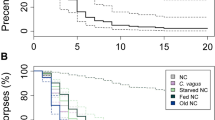Abstract
The response of the southern harvester ant,Pogonomyrmex badius, to oleic acid was found to depend on social context. Social context was specified as the number of ants engaging in each of five categories of behavior. When a large percentage of the colony is doing midden work or nest maintenance, papers treated with oleic acid are taken to the midden, as previously reported. However, when a large percentage of the colony is foraging or convening, treated papers are taken into the nest as if they were food items.
Similar content being viewed by others
References
Blum, M.S. 1970. The chemical basis of insect sociality, pp. 61–94,in M. Beroza (ed.). Chemicals Controlling Insect Behavior.
Gary, N.E. 1970. Pheromones of the honeybee, pp. 29–53,in D.L. Wood, R.M. Silverstein, and M. Nakajima (eds.). Control of Insect Behavior by Natural Products. Academic Press, New York.
Haskins, C.P., andHaskins, E.F. 1974. Notes on necrophoric behavior in the archaic ant,Myrmecia vindex (Formicidae: Myrmeciinae).Psyche 00:258–267.
Howard, D.F., andTschinkel, W.R. 1976. Aspects of necrophoric behavior in the red fire ant,Solenopsis invicta.Behav. Ecol. Sociobiol. 56:157–179.
Howard, D.F., Blum, M.S., Jones, T.H., andPhillips, D.W. 1982. Defensive adaptations of eggs and adults ofGastrophysa cyanea (Coleoptera: Chrysomelidae).J. Chem. Ecol. 8:453–462.
Jacobson, M. 1972. Insect Sex Pheromones. Academic Press, New York.
Marshall, D.L., Beattie, A.J., andBollenbacher, W.E. 1979. Evidence for diglycerides as attractants in an ant-seed interaction.J. Chem. Ecol. 5(3):335–344.
SAS User's Guide 1979. SAS Institute, Inc., Cary, North Carolina.
Wilson, E.O. 1963. Pheromones.Sci. Am. 208(5):100–115.
Wilson, E.O. 1978. Division of labor in fire ants based on physical castes (Hymenoptera: Formicidae: Solenopsis).J. Kans. Entomol. Soc. 51(4):615–636.
Wilson, E.O., Durlach, N.I., andRoth, L.M. 1958. Chemical releasers of necrophoric behavior in ants.Psyche 65(4):108–114.
Author information
Authors and Affiliations
Rights and permissions
About this article
Cite this article
Gordon, D.M. Dependence of necrophoric response to oleic acid on social context in the ant,Pogonomyrmex badius . J Chem Ecol 9, 105–111 (1983). https://doi.org/10.1007/BF00987774
Received:
Revised:
Issue Date:
DOI: https://doi.org/10.1007/BF00987774




